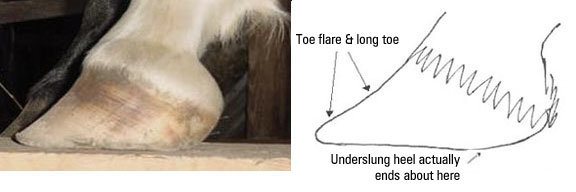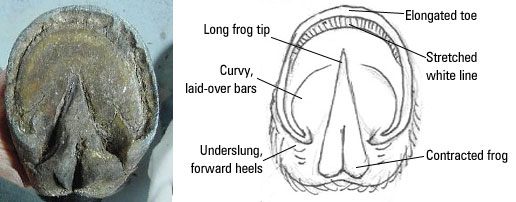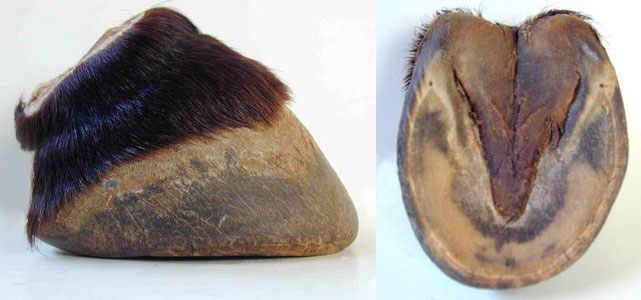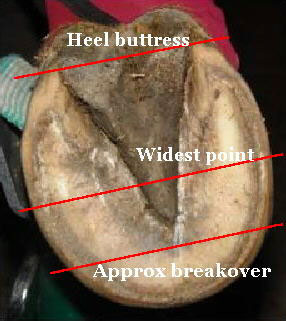Forward Foot Syndrome (FFS) by Walt Friedrick
This is a discussion about a common condition without a name, so I'm calling it Forward Foot Syndrome (FFS from now on). I'm not about to impart Gospel to you, it's just personal opinion. I have barefoot horses in mind, but these comments are by no means restricted to bare feet alone.
FFS is widespread, and we need to recognize it to prevent or fix it. Let's define it. I think most of you have seen Forward Foot Syndrome:
- long, pointy toe;
- underrun heels;
- contraction;
- improper (if any) breakover point;
- bars curvy and flat;
- frog long and narrow with the tip much too far forward and loose from the sole;
- and probably some wall flaring.
Photo examples of Forward Foot Syndrome


The first thing you need to know about it is that it is probably the most common and insidious problem for domestics' hooves. It sneaks up on your horse over time, and it happens because the horse is typically under-exercised and too heavy, And because he's getting trimmed improperly.
For comparison's sake lets look at some feral feet. I'm not saying our domestics' feet should look like ferals, but those examples are there to illustrate the difference between a healthy natural foot and one with Forward Foot Syndrome. Ferals are well-exercised, certainly not too fat, and they have (for their lifestyle) perfect trims. That means we've got our work cut out for us, but mark it: FFS can be remarkably easy both to prevent and to cure. Domestics are not doomed to develop FFS any more than ferals are.

A foot that starts out in perfect condition but then starts receiving an improper trim will take months, maybe longer, before you notice it's got FFS. You can be diligent, pay out plenty in farrier fees or sore backs in your effort to ensure good feet, yet Forward Foot Syndrome develops. Yet all it takes to prevent FFS is to observe just a few critical aspects of the trim itself.
Let's tackle the trim. What follows here is essentially the LIM trim - it's easy and very effective.
Here are the trim aspects you need to observe:
- First, trim frequently. A three-week cycle is a good compromise between overworking your back or pocketbook and running the danger of letting hoof growth get away from you.
- Second, at each trim study the feet on the ground before you pick one up. Make a mental note about what doesn't look quite right so you're sure to address it when you have hoof in hand. This is when you'll spot the existence of any flaring. Continue the study when you pick up the foot - the only tool you should have in your hand is your pick/brush, with your wire brush handy. Clean off the bottom thoroughly, including the commisures, so you can see all foot and no dirt. Now look to determine the cause of any anomalies you saw before picking up, as well as the condition of the sole components. Don't rush into rasping or cutting, take a moment and study what you've got, then plan out your work.
 |
That includes locating the widest distance across the foot, the location
of breakover, and the location of the heel buttresses. Gene suggests
you actually draw lines with a marking pen so you can see exactly what
you've got. See photo. Keep the 65-35 ratio (or thereabouts) in mind - if you don't see it, determine why: have the buttresses worked their way forward since the last trim? Has the breakover disappeared or moved? Plan for your corrective routine. |
- Finally, go to the trim. You're going to "fix" specific problems that you spotted during your evaluation phase, then give it the Old 1-2-3. That is, 1), take down wall all around to live sole plane, making sure the foot is balanced, 2) make sure the heel buttresses are where they belong according to the 65-35 concept. Bring them back close to the location of the frog buttress, which isn't gonna change. Then 3), rocker the toe to support/induce proper breakover point and apply a mustang roll.
That's what it takes to maintain the trim. But when correcting Forward Foot Syndrome, while all the above applies, the wall needs special attention. Depending on the severity of flaring, you may need to nip away the bottom of the wall. Some trimmers cut back the toe vertically. That's essentially the same as a severe rocker and mustang roll. The objective is to remove leverage from the extended wall digging into the ground. The advantage in applying the severe rocker/mustang roll is that you're in little danger of taking it back too far, but you may have to touch up the toe more often than every 3 weeks.
Some pertinent comments: Hinds don't get the toe rocker, but do get the mustang roll and you need to make sure the toe wall is not left too long. Because of the difference in shape between fores and hinds, the support ratio is probably closer to 50-50 in the typical hinds. Don't touch the toe callous on any foot. You may need to trim the bars with the knife if you're trimming to correct a case of FFS, but when you're trimming to maintain a good foot, the bars should need very little knife attention. Normally, the frogs don't need attention, but if they're stringy you can trim off the raggedy stuff. If they're deteriorated, you can apply whatever treatment you're using -- Kopertox, TTO or other. You can debride the sole if you wish, without cutting into the live sole itself.
The road to bringing Forward Foot Syndrome hooves back to health can be long, but you can do it. It's not difficult, and you must be diligent - do frequent trims and ALWAYS follow all the steps. Take "before" pictures so you can compare the "afters" - you may even frame them side-by-side, you'll eventually feel so good about it.